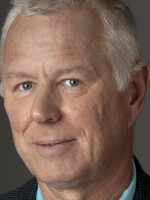SCOTT SIMON, host:
Archaeologists in Peru are pursuing a big idea that change in climate thousands of years ago altered the course of a civilization. Christopher Joyce recently learned firsthand how hard it can be prove big ideas on a small budget. Here's his Reporter's Notebook.
(Soundbite of banging)
CHRISTOPHER JOYCE: We're going out on a Peruvian lake and Dylan Betermetz(ph) is our anchor man.
Mr. DYLAN BETERMETZ: We're basically just filling these buckets with rocks and we're going to find some rope and use these buckets as anchors for our boat.
JOYCE: I'm following Jonathan Haas from the Field Museum in Chicago. He believes hunter-gatherers lived along the coast of Peru, until 5,000 years ago, the climate there changed. That forced them inland where they learned agriculture and built huge earthen mounds even before the pyramids of Egypt.
(Soundbite of splashing water)
Mr. JONATHAN HAAS (Field Museum in Chicago): We are in the Abu Fera del Media Mundo(ph), which is the Lagoon of the Middle Earth.
JOYCE: We row out in a 14-foot boat. Since these are dry-land archaeologists, I do most of the rowing.
Mr. HAAS: Weigh anchor!
JOYCE: What we're after are lakebed sediments. They contain pollen that could reveal climate changes. The coring device is a long metal pipe. A local mechanic cobbled it together for a couple hundred bucks or so. We have to whack it into the lake bottom.
(Soundbite of clanging)
Mr. HAAS: The hammer will pound it down into the sediment to the bottom. So we'll lower this thing down and you'll go (makes sound) with a hammer going down on it. It's a pile driver.
JOYCE: We take turns hammering, and despite the anchors, the boat spins around the corer like a dog leashed to a telephone pole. That takes half an hour. Then we have to twist the corer to grab some sediment, and finally we have to pull it out.
Mr. HAAS: Well, you just hold the pole. That'll keep us from bending it.
JOYCE: And the Lagoon of Middle Earth winds. The corer breaks in half, no sediment this time. They wonder what future archaeologists will make of a broken metal pole stuck in the lakebed like some Peruvian Excalibur. Haas is philosophical.
Mr. HAAS: You take a risk, you go experiment with something, sometimes it works and sometimes it doesn't. In this case it didn't but, you know, lots of other things are going just fine.
(Soundbite of splashing)
SIMON: Archaeologist Jonathan Haas with Christopher Joyce. You can get a photographic tour of his dig on our Web site, npr.org/climateconnections. Transcript provided by NPR, Copyright NPR.
NPR transcripts are created on a rush deadline by an NPR contractor. This text may not be in its final form and may be updated or revised in the future. Accuracy and availability may vary. The authoritative record of NPR’s programming is the audio record.





